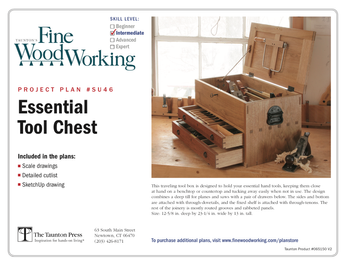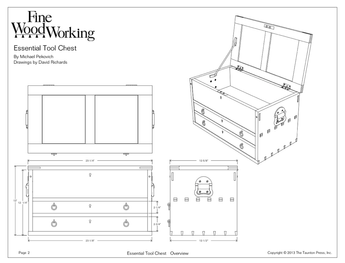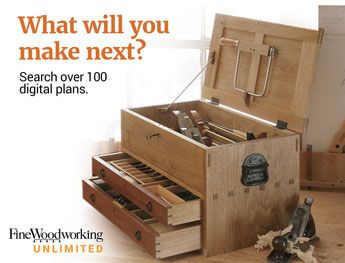For all those who think pocket screws are something new here is a look at an oldish desk made in a modern factory with production methods designed for efficiency. It is QSWO and been beat up and abused .
The size of each pocket hole is about an 1 1/8″ diameter they are huge and probably serve to weaken the material in those areas .Look under the top you can see the huge holes .
regards dusty , maker of pocket holes
















Replies
Neat Dusty.
Prolly a forstner bit, don't ya think?
Don ,
I don't think they used a standard forstner bit , the bit used was most prolly a version of a step bit like are commonly used for pocket holes today .The main difference is a protruding pilot that is not on a forstner as a rule .
regards from Paradise dusty
Dusty,
I have to say, I much prefer the look of those pocket holes to the ones made by today's jigs.
and www.flairwoodwork.spaces.live.com)
- Success is not the key to happiness. Happiness is the key to success. If you love what you are doing, you will be successful. - Albert Schweitzer
Hey Chris ,
They do look nice but they are huuuuuge and imo weaken the area ,you got to figure the pocket holes I make for face frames are like a 3/8" diameter these are way over an inch .This method has been used for eons to fasten tops to aprons on desks and table tops .
regards dusty
I knew that pocket screw joinery wasn't all that new, but that looks really OLD!!
One of your apprentice projects, Dusty? - lol
Dave ,
I did work on pieces like this during my apprenticeship but that was a long time ago .One of my best friends is a refinisher repairer , when he needs parts he can't make I always help him , and when I need to match a color or have a finish problem he is always there for me , so I agreed to make some parts and glue them on.
regards from Paradise dusty
I had a old desk my grandfather made. As I recall he told me he made it in the late 1920's. A few years after he got out of the Army in WWI. He was a cabinet maker and a Artillery Officer.
As far as I remember he said he fastened all his table/cabinet top slabs that way. Not sure, but I do not remember him telling or showing me any other joints where he used the recessed screws. He 'showed me everything' even if I did not want to at the time! But as a child I loved making and taking apart everything so I watched and listened. He could be a really nasty old man but just on rare occasion. At the time I just ignored his faults as I would assume most children do. Now, I would think, WWI got to him. Never hurt me though.. Just my pride on occasion...
He was wounded twice in the war and his wife died during it. His son was sent off to some orphanage and as I understand it took him about a year to find his child.
Anyway, long ago, I made a 18? 20? foot Cabin cruiser made from Popular Mechanic plans. 'Stick' ribs (frame) with old fashion Ply wood... I really do not remember where the plans called for them to be used but I recall making alot of them!
I was lucky.. My grumpy old grandpa left me in his will a wooden keg (about pony beer keg size?) filled with bronze screws of many different sizes! Sure worked nice in that boat. Not sure how strong bronze screws are but they did not rust! Actually the screws just held the wood in place while the Urea formaldehyde glue cured.
someone once gave me some boat deck Nails that were a twisted spiral like piece of what I think was Bronze as well as the screws for the boats also .
dusty
I don't know the age of this table I was asked to repair but this photo gives a new meaning to the the term "pocket hole" as we have come to know it. Certainly no jig was used.
Sorry about the size but I felt I needed 'large' so the screw could be seen.
Frosty
"I sometimes think we consider the good fortune of the early bird and overlook the bad fortune of the early worm." FDR - 1922
Yep! Like my grandfather made.
I've seen those on old furniture too...looks like most layfolk just chiseled out a triangular "pocket for the screw to seat against. I've also seen the giant ones although they look like they are drilled with a press and an auger tip spade- pilot and pocket in one plunge and no wandering. Never tried it myself but I use the new fangled kreg bit..easy peasy.
In the old days, eg the 1600s right through really until the early 1900s in many cases, fixing cabinet and table tops down using pocket screws was a standard technique. The method for excavating the pocket was with an in-cannel gouge and a round nosed carving chisel to get a flat seat for the screw head.
Very early in my career my employer at the time continued to use this method, even if only very occasionally. Even before then, when I was still at school in the 1960s and early 1970s where one of my woodwork teachers was a retired traditionally apprenticed cabinetmaker in his late 60s or early 70s he habitually used this method for the job; he also used buttons, but sneered at those 'new-fangled' (sic) metal L shaped expansion plates with convenient slots already cut for the job, ha, ha. Slainte.
richardjonesfurniture.com
Edited 8/22/2009 2:57 pm by SgianDubh
This forum post is now archived. Commenting has been disabled